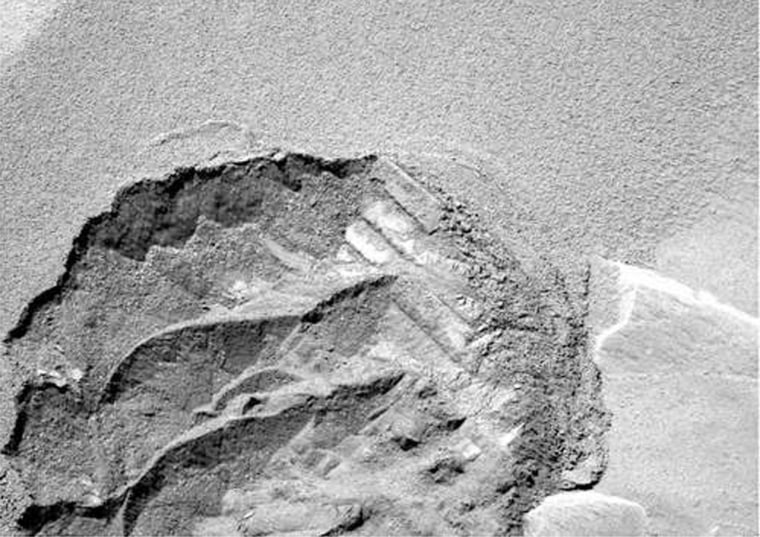Spectral images from the European Space Agency’s Mars Express orbiter show that there is plenty of water ice at the southern pole of Mars, French scientists said Wednesday.
Weeks after NASA’s Mars rovers uncovered geologic evidence that liquid water existed on ancient Mars, images from the OMEGA instrument aboard the Mars Express indicate its southern pole has three distinct areas containing water ice.
“We present the first direct identification and mapping of both carbon dioxide and water ice in the Martian high southern latitudes,” Jean-Pierre Bibring of the Institut d’Astrophique Spatiale in Orsay, France, said in a report published online by the science journal Nature.
Farther from the pole
The images were taken at the end of the summer on Mars, so they show that the ice is present all year. Bibring and his colleagues also observed exposed water ice in a region farther from the southern cap, where a large amount of water ice is thought to be buried.
The scientists deciphered the chemical makeup of the pole by studying the amounts of light and heat reflected from the area, allowing them to distinguish between dust, carbon dioxide and water ice.
“All the previous instruments did not have this capability of identifying all the components of what was observed,” Bibring said in a telephone interview.
The scientists will also be analyzing data from the northern pole of Mars, where water ice was previously known to exist.
“We will be in the process in the coming months of evaluating the global surface of water and CO2 (on Mars),” Bibring added.
Following the water
The latest evidence, combined with findings from NASA’s rovers, gives scientists more information about whether the conditions to sustain life existed on Mars in the past and if the planet could support life in the future.
“The answers depend on understanding the past and present distribution of both water and CO2,” Timothy Titus of the U.S. Geological Survey in Flagstaff, Ariz., said in a commentary on the research.
Water would be needed to support a human mission to the planet. Determining how much and where the water is located is also necessary to understand Martian climates.
“Human exploration, and ultimate colonization, of Mars depend on accessibility to one resource — water,” said Titus.
“Martian water is necessary not only for human consumption, but is also the key to making breathable air and fuel for the return trip to Earth. For life on Mars, water is the elixir,” he added.
Rover update
Meanwhile, NASA's Spirit rover spent Wednesday studying a drift of windblown Martian sand or dust on the rim of the Bonneville crater. The golfcart-sized probe used one of its six wheels to "scuff" the surface of the drift, revealing the material beneath the surface. It then made observations of the scuffed area with its cameras and its mini-thermal emission spectrometer.

Scientists planned to look at areas of the drift, nicknamed "Serpent," with Spirit's microscopic imager. The rover would also use its onboard instruments to determine whether the Martian material was more like sand or like dust.
On the other side of the planet, Opportunity ventured away from the bedrock outcropping it has been studying for the past several weeks, then began a survey of the soil close to the rim of the crater where it landed almost two months ago.
NASA's $820 million mission is aimed at documenting evidence that Mars was once wet enough to allow for the development of life. The rovers are more than halfway through the scheduled 90-day primary mission, but managers at NASA's Jet Propulsion Laboratory in Pasadena, Calif., say that both spacecraft are healthy and could be in operation for more than 200 days.
